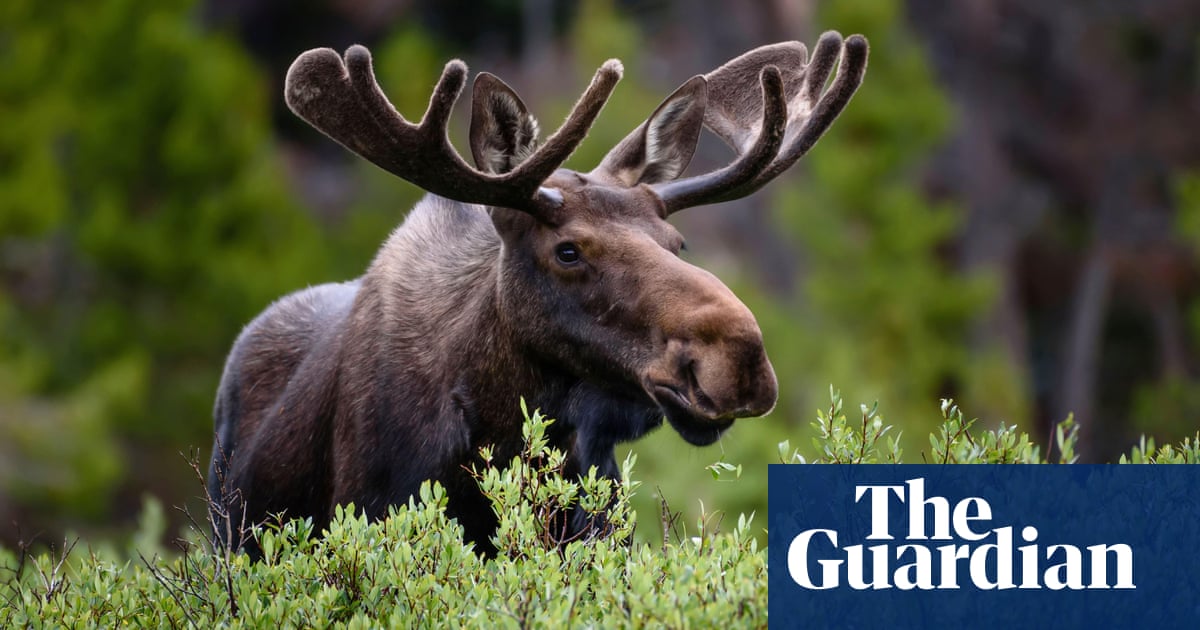‘No chain stores, but moose on every corner’: as Colorado herds thrive, clashes with people rise | Wildlife


One morning in the winter of 1978, a handful of state wildlife staff huddled together in the Uinta Mountains in north-eastern Utah. Deep snows coated the peaks and filled the valleys. A pair of helicopters cruised over the frozen landscape, helping those on the ground search for their prize: a cow moose in a snowy meadow.
Crouched in one of the aircraft, a man aimed his rifle: there was a sharp report, and the cow took off at a run. Within minutes her legs went wobbly as the tranquilliser in the dart took effect, and the crew landed and got to work.
They tagged and collared the moose, then slid a specially designed sling under her belly, attached by a rope to one of the helicopters. For a moment, as the pilot eased into the air, the moose lurched, drawing her legs upward as her feet left the ground.
But then the animal appeared to relax as she soared over the rugged valley, bound for her new home more than 200 miles away in Colorado’s North Park region near Walden– a vast expanse of sagebrush and willow between two mountain ranges.
Few creatures evoke the American wilderness like Alces americanus, the American moose. It is the second-largest land animal in North America, behind the bison. Its imposing size is undercut by a goofy countenance – the wide fan of horns, thin legs that suspend a hefty body and a face like a hand- puppet fashioned from a worn-out sock.
Despite their ungainly appearance, however, moose are formidable and sometimes graceful, reaching speeds of 35mph at full gallop. Over time, in Colorado, the moose has emerged as a potent symbol and ambassador of the wild in a state enamoured of its outdoor places, depicted in murals and statues in many mountain towns.
But as much as Alces americanus seems to belong in Colorado, its native range does not extend into the state. Colorado’s wildlife department introduced moose in the 1970s to help generate revenue through the sale of hunting licences. In that era of wildlife management, the decision of a few high-ranking state officials was enough to set a great ecological experiment into motion.
“We brought them to Colorado because we could,” said the late Gene Schoonveld, a biologist at the forerunner to Colorado Parks and Wildlife, who was among the officials to set the translocation in motion (Schoonveld died in 2022). “We had the space and the habitat for them.”
Now, that experiment is reaching a head, and thousands of wild moose roam the state’s woodlands and mountains – coming into increasing and often deadly conflict with humans.
Though they are notoriously hard to count, there are now an estimated 3,000 moose scattered through Colorado’s major mountain ranges. That figure, however, does not adequately describe their growing presence – or the way they have transformed the landscape. The comment sections for dozens of hikes on the popular AllTrails app now contain a litany of moose sightings.
Moose have even made their way into the suburban sprawl of Denver, the state’s capital, browsing in the green belt, sauntering across golf courses or loitering in shopping centre car parks.
As Colorado’s human and moose populations have grown, so have the number of conflicts between them. Moose attacks in the state now outnumber attacks by bears and pumas (also known as mountain lions or cougars) combined, even though moose numbers are significantly lower.
Over two weeks in the spring of 2022, moose attacked people in three separate incidents. Near the mountain town of Nederland, a cow moose trampled and severely injured a hiker and a dog; a police officer shot her and wildlife officials took her calf into custody. In September 2022, a moose gored and nearly killed a bowhunter in northern Colorado after the hunter’s arrow whistled wide of its mark. More often than not, however, moose come out on the losing end of these clashes. According to the Colorado Department of Transportation, cars struck and killed 59 moose in 2022. In 2012, the number was just four.
In State Forest park, where officials originally released moose in 1978, as many as 700 now roam the area. “It’s the last frontier,” says Tony Johnson, a State Forest ranger. “There are no chain stores, but moose on every corner.”
Human values have always shaped wildlife policy. In Colorado and elsewhere in the American west, mountain goats, elk and bison have been introduced to places where they never lived before or have been sustained in unnaturally high numbers to satisfy hunters and wildlife watchers. Those efforts have frequently changed the environment dramatically.
Amid the rich willow stands of North Park, the two dozen transplanted moose flown to the state kicked into reproductive overdrive, with many producing two offspring at once – a phenomenon called “twinning” that occurs when food is especially plentiful. A decade after their introduction, the moose population had grown to about 250.
The animals proved so successful and popular with residents and visitors that, between 1987 and 2010, wildlife officials transplanted more moose to other parts of Colorado, where they also thrived.
“Biologists generally expected them to do well,” Eric Bergman, a research scientist and moose specialist with Colorado Parks and Wildlife, “and they certainly did.”
Rocky Mountain national park, just east of North Park, is among the places that have witnessed that rapid growth. Park biologists estimate that 40 to 60 moose now wander the western side of the park.
At the Rocky Mountain park headquarters, a landscape ecologist, Will Deacy, shows an infrared image of a mountainside covered in dark trees. A closer look revealed white silhouettes scattered among the pines: moose going about their mysterious business. “They are a new species in a new context,” Deacy said. “There is so much we just don’t know.”
One of those unknowns is just how moose will affect a landscape already heavily browsed by native elk. Settlers nearly hunted elk to extinction in this part of the state, but in 1913, officials reintroduced them within the protective boundaries of the national park. By the late 20th century, elk here also no longer faced predation by wolves or grizzlies.
The herd ballooned to as many as 3,500 animals by the early 2000s – far more than the maximum of 2,100 that the park service deem sustainable – and rapidly chewed through willow stands. The park’s willows, a keystone species throughout the Rockies, declined by 96% between 1999 and 2019.
With moose now inhabiting every major valley within the park, there is a fear that these larger animals could have a similar impact.
According to biologists, an adult moose can eat up to 27kg (60lb) of willow a day, far more than an adult elk, which consumes roughly a third of that amount of forage, only a fraction of which is willow. And because national parks ban hunting, moose tend to congregate within their borders, achieving densities almost five times higher than outside them.
That could create new problems for willows and the myriad creatures that depend on them. Research in Grand Teton and Yellowstone national parks by Joel Berger, a wildlife biologist at Colorado State University, found that migratory songbirds, such as warblers and flycatchers, occur at much lower densities where there are large populations of moose.
“People love their moose,” says Elaine Leslie, former chief of the National Park Service’s biological resource management. But too many of the animals could threaten “the primary purpose of the park, which is the preservation of resources”.
Leslie sees a potential solution in the reintroduction of wolves to Colorado, which brought 10 animals to the central Rockies in December 2023. Wolves are the main predator of elk and moose, and could ease pressure if they recolonise an area and reduce populations or induce herds to keep moving.
If natural means of moving moose do not work, the park might be forced to explore other, more extreme options such as darting the animals with contraceptive drugs or, in the worst case, culling them.
While Leslie calls moose “one of my favourites,” she says: “I’m worried about what is happening at the ecosystem level, especially in Rocky Mountain national park. That is a very biodiverse area right now.”
Despite growing pains as Coloradoans figure out how to co-exist with this large, non-native ungulate, the state has become something of a de facto refuge for the species. Moose populations in much of their native range across the northern US are plummeting.
In New Hampshire, they declined by nearly half from the mid-1990s to late 2010s, owing to habitat loss and warming temperatures, which triggered a sharp rise in ticks. Wyoming was a stronghold of the species, but today Colorado has more moose than its northern neighbour. And there are signs that Colorado’s moose numbers may be naturally stabilising: lower pregnancy rates and animals skipping breeding.
Communities are learning to coexist with the animals. In Walden, moose are such frequent visitors that a sign outside town proudly proclaims it to be the “Moose viewing capital of Colorado”.
“We have them in town quite often,” said Josh Dilley, State Forest’s park manager. They especially like to congregate around the elementary school, he explained, “so we’ll go sit strategically between the moose and the kids while they’re going to school.” When moose loiter too long in front yards and public parks, rangers scare them away with firecrackers or non-lethal rubber buckshot. On rare occasions, they sedate an unruly moose with a dart and take it elsewhere by truck.
Still, Leslie warns, without stronger controls and monitoring, Colorado could face increasingly denuded stream banks, more frequent attacks and car collisions – and more moose in the crosshairs.
“It’s partly everybody’s fault – the state and the feds – because we don’t think into the future very well and we don’t learn from history,” Leslie says. “Unless everybody gets on the same page, it’s going to get ugly.”
Source link




